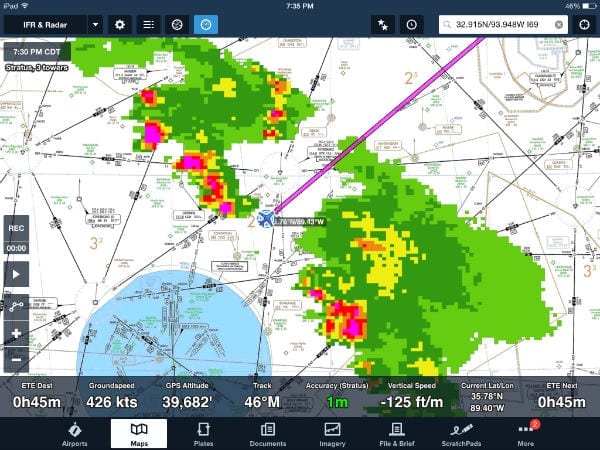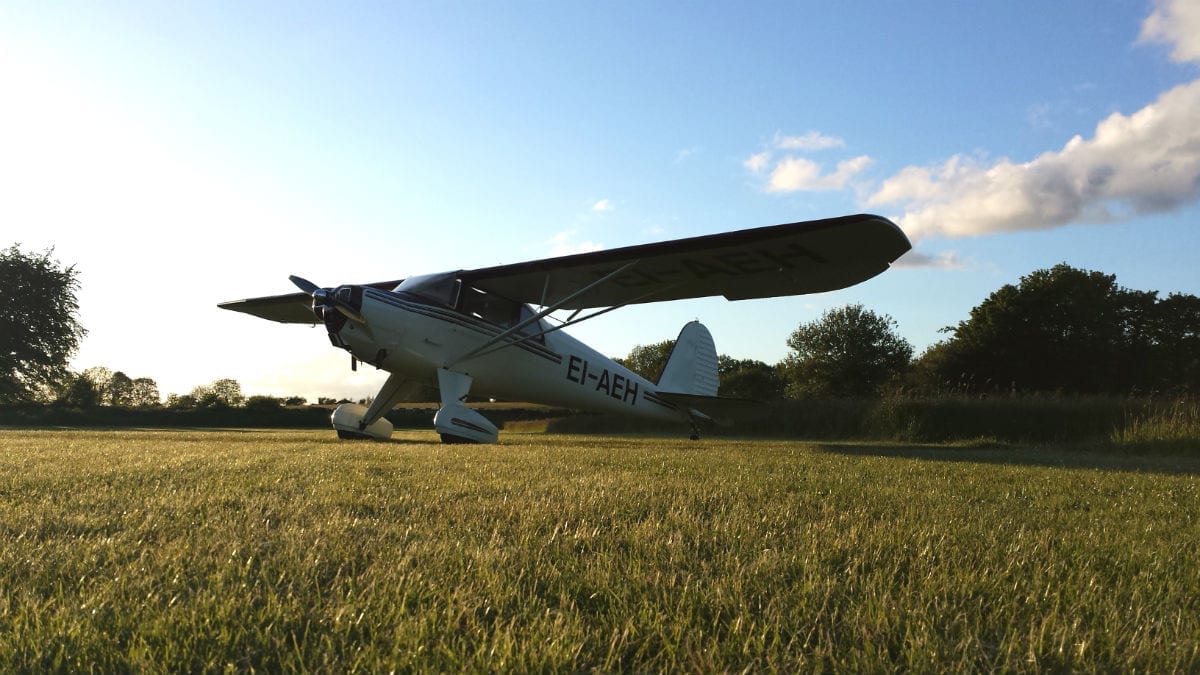
One chance to get it right: inadvertent IFR flying
I Can't Believe I Did ThatI immediately knew that my current situation was extremely serious. I was currently flying at 4000 feet and was trapped between two layers of cloud in a wide band of clear air. This “meat in the sandwich” scenario at the end of the day, in a low speed, basically instrumented aircraft with a relatively low-time pilot was about as bad as it could get.

Friday Photo: putting the plane away
Friday PhotoGreat aviation pictures don't always happen in the air. This week's Friday Photo shares the simple pleasure of a family flight, and the joy of introducing young people to flying. Reuben Keim captured this memorable shot of his son Luke and his two cousins as they pushed the airplane back in the hangar after a flight. Airplanes and family - a perfect combination.

How to interpret radar in the cockpit
John's blogRadar seems so simple at first: red is bad, green is good. What else is there to know? As any pilot with more than a few cross countries in the logbook knows, quite a lot. While a lot of the problems with radar operation have been solved by datalink weather, few of the problems with radar interpretation have been solved.

Video tip: avoiding turbulence
Video TipNobody likes a bumpy flight, but forecasting turbulence isn't as easy as forecasting IFR conditions or thunderstorms. In this video tip from Sporty's Takeoff App, explore common causes of turbulence, plus tips for avoiding the worst rides.

I was a “weather coward,” and I made the right decision
I was there"Hey jerk face!" my conscience screamed. "What about PILOT IN COMMAND don't you understand? Who makes the decisions around here? The line boy? Is this a good idea or not? If it's not, grow a pair and do what you know to do!”

Friday Photo: Sydney Harbour from an Archer
Friday PhotoSydney, Australia, has one of the world's most photogenic harbors, from the famous opera house to the historic bridge. The view is even better from the air, as David Grabham shows in this week's Friday Photo. He gave a couple of friends the scenic tour in his Piper Archer and snapped this beautiful photo.

North to Alaska
I was thereA friend and I discussed flying to Alaska as he knew a fellow who had expressed a desire to see the northern state. I called a pilot friend who became the other front seat. He was not yet multiengine-rated although he was a competent instrument-rated pilot. I reserved the Twin Comanche for mid-July 1982 for our flight.

Drop everything to fly a DC-3? Absolutely
I was thereMy phone dinged as the text message came through. "Can you spend the day in Griffin tomorrow?" I had a lesson first thing in the morning, but was otherwise free. I asked Dan what was going on. "DC-3 flying. Emerg." I didn't need any other details and I made arrangements to change what would have been a lazy Saturday into one that would doubtlessly not be boring.

An awful sensation – lost above Brazil with no alternator
I Can't Believe I Did ThatI was totally by myself. I aligned the plane with the 04 runway, with no one in sight, since it was the middle of the week. I took off and decided to test the new plane with some basic maneuvers and a lazy flight. It's important to say that I was totally unfamiliar with the area, as I was used on flying my Cubs from another airfield some miles away. But the fates decided it was a good time to put me to the test.

Friday Photo: Smoky Mountain Rainbow
Friday PhotoCommuting by airplane isn't always as glamorous as it sounds, but this flight was a great reminder for McGregor Scott of how beautiful the view is from the cockpit. He snapped this photo of a rainbow just ahead of a rain shaft over Chatuge Lake in northern Georgia, while flying his Trinidad from Kentucky to Florida.

It was more than adventure
I was thereWhile I have written about the adventures or misadventures of flying during my career, I don’t wish to leave the impression that I was in constant danger or that my career could be characterized as hazardous; it wasn’t. There were times when I witnessed unbelievable beauty—sights that I wished my loved ones could have shared.

Out of control – flying a vintage airplane in Ireland
I was there“Don’t you have to get permission from ATC or someone?” That’s the most common question I get when people discover I launch myself into the sky from a field. Confusion then turns to disbelief when I tell them “nope.” I usually let that little pot of incredulity simmer for a while; sometimes I’ll stir things with a “why would I need permission?”

Quiz: sectional charts
QuizEven with iPads and iPhones, the sectional chart is still an essential tool for pilots. From planning a route to avoiding restricted airspace, no other resource packs as much information into a single page. How much do you know about all the airspace, airport, and obstacle symbols? Take our latest quiz to find out.

Ferrying the “Pokey Porter” 13,000 miles
I was thereThis account concerns the delivery of one Fairchild Heli-Porter PC-6 from the factory in Maryland to Yosu, South Korea. As a pilot for World Aviation Services, Inc., I have been assigned the delivery and will train a Korean crew upon arrival. The Heli-Porter is a single engine, turboprop, short takeoff and landing aircraft capable of carrying eight persons 420 miles at an optimum speed of 115 knots, hence my private nomer of "Pokey Porter."

Friday Photo: Golden Gate Bridge
Friday PhotoAs a new pilot, I’ve been nervous about going through class B airspace. Today was a perfect VFR day, and I took the plunge. I took a trip up the California coast past Half Moon Bay, across San Francisco, and then straight down highway 101 past KSFO. The controllers were fast and furious, but the flight was beautiful and uneventful.

What it takes to be one sharp pilot, part four: realistic
Dick's blogIn this off-again on-again series I have touched on awareness, intelligence and coordination. Those are all important. Being realistic also sounds like part of a plan for flying. The first thing that comes to mind is the extremely tired old saw about knowing your (or your airplane’s) limitations. In fact, that has been said with evangelical zeal so many times that, with this mention, I am going to leave it behind.

My introduction to bush flying in Panama
I was thereWhat am I doing here? I’m flying at 3,500 feet over water, heading into the unknown in a single-engine Cessna, and it’s dark! This is what I asked myself as I flew 10 miles out over the Bay of Panama before dawn.

Growing up near a grass strip
I was thereMy uncle and his friend opened up a flight training school after the war on our family's Northern Indiana dairy farm with a 3000-foot grass strip and farm-engineered hangar. Many former military pilots and a lot of local people took lessons and rented planes. I was enchanted with all the activity.

Friday Photo: Twin Bonanza sunset
Friday PhotoSeeing a beautiful sunset is one of the reasons pilots learn to fly. For Chris White, though, this sunset was even more special than usual. Sure, the Twin Bonanza he was flying is a unique and interesting airplane. But he was most proud of the mission he was flying: to transport a WWII Medal of Honor recipient to the groundbreaking for a memorial.

Just like a fly on the windshield
I was thereI advanced the throttle to full power; confirmed that both aircraft and all the associated equipment were going in the same direction at the same time and stole a glance in my rearview mirror. I noticed what looked like a big cloud of smoke off to the right side of the glider (George’s position). Curious.
